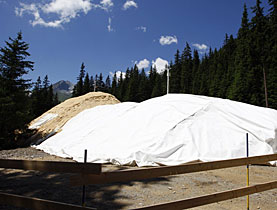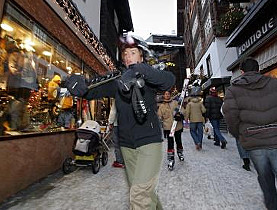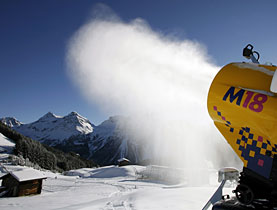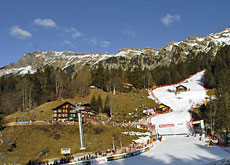Sawdust slows rate of melting snow

Snow can be stored over summer at relatively low altitudes, the Swiss snow and avalanche research institute has revealed.
An experiment in the eastern resort of Davos found that a thick layer of sawdust reduced the rate of melting better than fleece, which is also used to conserve glaciers.
“Both methods work, but the lower the snow level the greater the advantage of sawdust,” Hansueli Rhyner, the institute’s project leader, told swissinfo on Friday.
In June researchers in Davos, which lies at an altitude of 1,560 metres, shovelled 2,500 cubic metres of snow into a seven-metre high pile. Half was covered with fleece and half with a 40cm layer of sawdust.
The natural method turned out to be significantly superior, the institute said. Around three-quarters of the snow remained under the sawdust, whereas only a fifth was left under the fleece.
“I was surprised how well it worked with sawdust,” Rhyner said. “I was slightly surprised how much snow melted under the fleece, but there are of course simple measures one can take to improve the situation.”
Part of the pile was covered with a second fleece, which reduced the rate of melting even more.
A total of 900 cubic metres of snow remained, and it was taken to a nearby cross-country skiing piste.
“Most of it was artificial snow but that doesn’t play a particularly big role,” Rhyner said. “The important thing is that the pile is packed relatively densely. The denser the better.”
Challenges
Although fleece is already used to slow the speed at which glaciers melt, other challenges exist when storing snow at 1,500 metres, which is on average five to eight degrees warmer than at glacier level.
At that low of a level, simply keeping snow or ice out of sunlight isn’t enough, said the researchers – a layer of insulation is also needed to reduce the effects of the surrounding air temperature.
Sawdust fulfilled this task better than fleece, although Rhyner admitted that, when deciding what material to use, fleece was easier to transport and store than sawdust.
He added that they hoped to use the data to develop a model that will be able to work out the melt rate for any location and the efficiency of the various methods.
“Storing snow is worthwhile for a tourist resort particularly if it is tied in with a specific event or training session at the start of the season,” said Norbert Gruber, head of technical services at Davos tourism.
“From an economic point of view it would be cheaper to use the snow canon, but it’s not guaranteed that at the end of October or beginning of November the temperatures are low enough for that.”
swissinfo, Thomas Stephens
Snow farming is the management of snow supplies and reserves. It is practised by many ski resorts with a view to keeping the slopes well stocked with snow to attract visitors, and also by some governments to conserve water reserves in the form of snow. Individuals may also engage in snow farming with the goal of keeping their homes and gardens in optimal condition in the winter.
Snow can be transferred to areas used for holding, in which case it is typically covered with heavy material to slow the rate of melt. Many ski resorts practise this form of snow farming with the goal of reducing the amount of artificial snow they will need to create in the winter.

In compliance with the JTI standards
More: SWI swissinfo.ch certified by the Journalism Trust Initiative




You can find an overview of ongoing debates with our journalists here. Please join us!
If you want to start a conversation about a topic raised in this article or want to report factual errors, email us at english@swissinfo.ch.